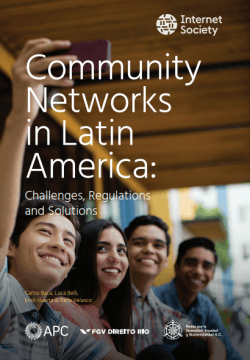Authors: Carlos Baca, Luca Belli, Erick Huerta & Karla Velasco
Over the past decade, numerous discussions have highlighted the essential role that Internet connectivity plays in driving fundamental changes in economic and social development.
By reducing the costs of access to information and knowledge and expanding the ability to share innovation, connectivity has the potential to empower people, improve access to public services, increase productivity and promote greater civic participation. In many parts of the Americas, however, Internet penetration is still lagging behind most developing countries and, consequently, Information and Communication Technology (ICT) literacy, ICT adoption and opportunities for users are still quite limited.
This study begins by describing the current situation which, on the one hand, shows the difficulty governments face in designing and implementing policies that can take advantage of the opportunities and reap the benefits of Internet connectivity and, on the other, exposes the inability of the agents present in the market to offer affordable access to a substantial part of the population. The situation varies greatly among the different countries, income groups and urban or rural populations, but the options available in most of Latin America are often too expensive compared to the population’s resources and the quality of connectivity remains very limited. For these reasons, about half of the population is still without Internet access[1].
In this context, in recent years the number of community networks has grown throughout the continent, providing a credible “community connectivity” alternative to the traditional model used to provide Internet access in Latin America. However, the establishment and expansion of community networks depend on countless variables ranging from the existence of efficient and sustainable local organizations, the availability of technological capabilities, the number of available resources, and the existence of friendly environmental conditions, to institutional and regulatory conditions that favor or hinder the implementation of such community networks.
While the community network model seems relatively easy to implement and operate, little is known about existing models and the options available for their organization and maintenance, or about which conditions can facilitate their implementation and success.
For this reason, the purpose of this study is not only to highlight the potential of community networks in terms of expanding connectivity and its positive social, cultural and economic externalities, but also to point out the regulatory elements that might optimize their development and highlight the regulatory experiences that have allowed removing obstacles to the full operation of community networks in Latin America.
One of the most important aspects of this study is the use of descriptive elements in its different sections in order to adopt a proactive attitude and offer specific instructions and recommendations. These elements seek to clarify how community networks might be categorized from a legal point of view, which rules should be considered when regulating community networks, and what policies should be adopted to promote and strengthen the expansion of community networks in Latin America.
[1] ITU Broadband Commission (2017) Connecting the Unconnected: Working together to achieve Connect 2020 Agenda Targets. Available at: http://broadbandcommission.org/Documents/ITU_discussion-paper_Davos2017.pdf.
